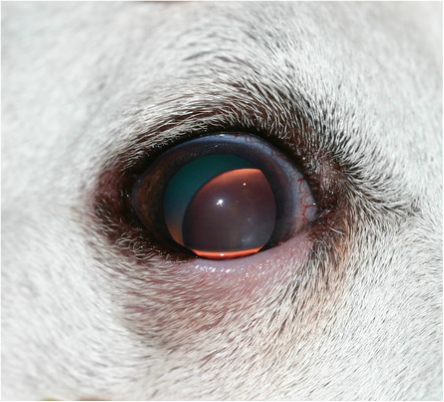Lens LuxationWhat is it?
In this condition the lens becomes dislocated from its normal position. The ligaments (called zonules) which suspend the lens are ruptured and no longer hold the lens in its normal position. The displaced lens can be found in the front of the eye (anterior lens luxation), in the back of the eye (posterior lens luxation), or only partially displaced (lens subluxation). This condition can be primary (common in terriers and older cats) or can be secondary to other complicating ocular conditions such as glaucoma or uveitis. Primary luxated lenses can induce secondary diseases including glaucoma, uveitis, and retinal or optic nerve diseases. Additionally, abnormal vitreous displacement into the pupil and front of the eye can be common in lens luxation /subluxation cases. These other ocular diseases would also concurrently need to be treated. If the eye has the potential to regain / retain vision, a lens extraction surgery (lensectomy) may be considered. The lensectomy would have all the same potential complications as cataract surgery. If the eye is already blind, other medical /surgical treatments can be discussed. What are possible complications of luxation? The long term outcome for patients with medically managed lens luxation and subluxation is unknown as there are no long term studies at this point evaluating visual outcome in these cases. Seconday glaucoma has been reported in 73% of anterior lens luxation cases, 43% of subluxated lens and 38% of posterior lens luxation. |
Symptoms |
Common signs of ulcers can include:
-pain (squinting, rubbing at the eye, loss of appetite, hiding) -redness -cloudy cornea -increased discharge |
Treatment |
Early removal of displaced lens is recommended to give the best chance of long term vision and avoidance of secondary glaucoma. Unfortunately these risk remain present even with surgery including, but not limited to, retinal disease and detachment, glaucoma, corneal edema, intraocular hemorrhage, prolonged uveitis, intraocular adhesions, endophthalmitis, and phthisis bulbi (shrinking of the eye). Diabetic patients may be at a slightly greater risk for of lipid aqueous and may take longer to heal. Medical therapy and surgical procedures may be necessary to treat newly acquired disease as it occurs.
|

